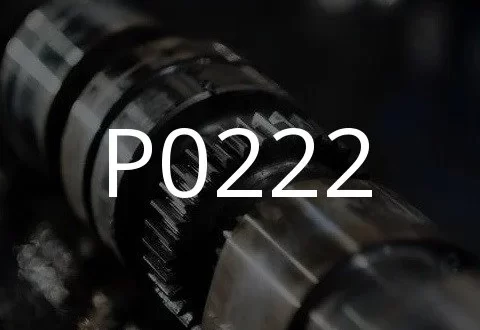
P0222 Throttle Position Sensor “B” Circuit Low Input
Content
P0222 – OBD-II Trouble Code Technical Description
Trouble code P0222 indicates a low input signal from the throttle position sensor B.
What does the fault code mean P0222?
Trouble code P0222 refers to problems with the Throttle Position Sensor (TPS) “B”, which measures the opening angle of the throttle valve in the vehicle's engine. This sensor sends information to the electronic engine management system to regulate fuel delivery and ensure optimal engine performance.

Possible reasons
Some of the possible causes of the P0222 trouble code are:
- Throttle Position Sensor (TPS) malfunction: The sensor itself may be damaged or have worn contacts, causing the throttle position to be read incorrectly.
- Problems with wiring or connections: Wiring, connections or connectors associated with the throttle position sensor or ECU may be damaged, broken or corroded. This may cause incorrect or irregular electrical connections.
- Defect in the ECU (Electronic Control Unit): Problems with the ECU itself, which processes signals from the throttle position sensor, can cause the P0222 code.
- Throttle problems: Sometimes the problem can be with the throttle valve itself, for example if it is stuck or warped, preventing the sensor from reading its position correctly.
- Incorrect installation or adjustment of the throttle position sensor: If the sensor is not installed correctly or is configured incorrectly, it can also cause P0222.
- Other factors: Sometimes the cause may be external factors such as moisture, dirt or corrosion, which can damage the sensor or connections.
If you are experiencing a P0222 code, it is recommended that you take it to a qualified auto mechanic for diagnosis and repair.
What are the symptoms of a fault code? P0222?
Symptoms for a P0222 trouble code can vary depending on how severe the problem is and how it affects throttle position sensor (TPS) performance and engine management, some of the possible symptoms are:
- Uneven engine operation: An incorrect signal from the TPS may cause the engine to run rough at idle or when driving. This may manifest itself as a rattling or rough idle, as well as intermittent jerking or loss of power when accelerating.
- Gear shifting problems: An incorrect TPS signal can cause shifting problems, especially with automatic transmissions. This may manifest itself as jerking when changing gears or difficulty changing speeds.
- Increased fuel consumption: Since an incorrect TPS signal may cause the engine to run unevenly, it may increase fuel consumption as the engine may not operate efficiently.
- Acceleration issues: The engine may respond slowly or not at all to throttle input due to an incorrect TPS signal.
- Error or warning on the instrument panel: If a problem is detected with the throttle position sensor (TPS), the electronic engine control system (ECU) may display an error or warning on the instrument panel.
How to diagnose a fault code P0222?
Trouble code P0222 (Throttle Position Sensor Error) requires several steps to diagnose the problem:
- Reading the fault code: Using an OBD-II scanner, you need to read the P0222 trouble code. This will give an initial indication of what exactly might be the problem.
- Checking wiring and connections: Check the wiring and connections related to the Throttle Position Sensor (TPS) and the ECU (Electronic Control Unit). Make sure all connections are intact, free of corrosion and well connected.
- Resistance test: Using a multimeter, measure the resistance at the throttle position sensor (TPS) output terminals. The resistance should change smoothly as you move the throttle. If the resistance is incorrect or varies unevenly, this may indicate a faulty sensor.
- Voltage test: Measure the voltage at the TPS sensor connector with the ignition on. The voltage should be within the manufacturer's specifications for a given throttle position.
- Checking the TPS sensor itself: If all wiring and connections are ok and the voltage at the TPS connector is correct, the problem is likely with the TPS sensor itself. In this case, the sensor may need to be replaced.
- Checking the throttle valve: Sometimes the problem may be with the throttle body itself. Check it for binding, deformation or other defects.
- ECU check: If everything else is fine, the problem may be with the Electronic Control Unit (ECU). However, diagnosing and replacing an ECU usually requires specialized equipment and experience, so it may require the assistance of a qualified technician.
After completing all these steps, you will be able to determine the cause of the P0222 code and begin troubleshooting it. If you do not have experience with cars or modern control systems, it is recommended that you contact a professional auto mechanic for diagnosis and repair.
Diagnostic errors
When diagnosing DTC P0222, the following errors may occur:
- Incorrect interpretation of diagnostic results: An error may occur due to incorrect interpretation of test or measurement results. For example, misinterpreting the multimeter reading when testing the resistance or voltage of the TPS sensor can lead to incorrect conclusions about its condition.
- Insufficient checking of wiring and connections: If not all wiring and connections have been checked carefully, it may result in missing a factor that may be causing the problem.
- Replacement of a component without preliminary diagnostics: Sometimes mechanics may assume that the problem is with the TPS sensor and replace it without conducting a full diagnosis. This may result in replacing a working component and not addressing the root cause of the problem.
- Ignoring other potential causes: When diagnosing the P0222 fault, it may focus only on the TPS sensor, while the problem may be related to other components such as wiring, connections, throttle body or even the ECU.
- Ignoring external factors: Some problems, such as corrosion of connections or moisture in connectors, can be easily ignored, which can lead to misdiagnosis.
- Unaccounted for joint problems: Sometimes the problem may be the result of several faults together. For example, problems with the TPS sensor can be caused by both wiring faults and problems with the ECU.
- Fixing the problem incorrectly: If the cause of the problem is not correctly identified, resolving the problem may be ineffective or temporary.
To successfully diagnose a P0222 code, it is important to be attentive, thorough, and follow a systematic approach to identifying the causes and correcting the problem.
How serious is the fault code? P0222?
Trouble code P0222 associated with the Throttle Position Sensor (TPS) error is quite serious because the TPS sensor plays an important role in controlling the vehicle's engine. Several reasons why this code may be considered serious:
- Loss of engine control: An incorrect signal from the TPS sensor can cause loss of engine control, which can result in rough running, loss of power, or even complete engine shutdown.
- Deterioration in performance and economy: A malfunctioning TPS sensor may result in uneven fuel or air flow to the engine, which may impair engine performance and fuel economy.
- Possible transmission problems: On vehicles with automatic transmission, an incorrect signal from the TPS sensor may cause shifting problems or shift jerkiness.
- Increased risk of an accident: Unpredictable engine behavior caused by P0222 can increase the risk of an accident, especially when driving at high speeds or in difficult road conditions.
- Damage to the engine: Improper engine fuel and air management can cause excessive heat or other engine damage in the long run.
Overall, the P0222 trouble code requires serious attention and repair to prevent serious consequences.
What repair will help eliminate the code? P0222?
Trouble code P0222 typically requires the following steps to resolve:
- Checking and cleaning connections: The first step may be to check the wiring and connectors related to the TPS sensor and the ECU (Electronic Control Unit). Poor or oxidized connections can cause the sensor to malfunction. In this case, the connections should be cleaned or replaced.
- Replacing the Throttle Position Sensor (TPS): If the TPS sensor is faulty or its signal is incorrect, it is recommended to replace it with a new one. This may require removing the throttle body to access the sensor.
- Calibrating a New TPS Sensor: After replacing the TPS sensor, it often needs to be calibrated. This is usually done according to the vehicle manufacturer's instructions. Calibration may involve setting the sensor to a specific voltage or throttle position.
- Checking and replacing the throttle valve: If the problem is not resolved by replacing the TPS sensor, the next step may be to check the throttle body. It may be jammed, deformed, or have other defects that prevent it from working properly.
- Checking and, if necessary, replacing the computer: If all of the above steps do not resolve the problem, the Electronic Control Unit (ECU) may need to be diagnosed and, if necessary, replaced. This, however, is a rare occurrence and is usually performed as a last resort after other possible causes of the malfunction have been ruled out.
After repairs are completed, it is recommended that the engine management system be tested using an OBD-II scanner to ensure that the P0222 code no longer appears and that all systems are operating correctly.
P0222 – Brand-specific information
Trouble code P0222 refers to a throttle position sensor (TPS) error and can occur on various makes of vehicles. Several decodings of the P0222 code for some specific brands:
- Volkswagen / Audi / Skoda / Seat: Throttle/Petal Position Sensor/Switch B Circuit Low Input Error.
- Toyota / Lexus: Throttle/Petal Position Sensor/Switch “B” Circuit Low Input Error.
- Ford: Throttle Position Sensor/Switch B Circuit Low Input error.
- Chevrolet / GMC: Throttle/Petal Position Sensor/Switch “B” Circuit Low Input Error.
- BMW/Mini: Throttle/Petal Position Sensor/Switch “B” Circuit Low Input Error.
- Mercedes-Benz: Throttle/Petal Position Sensor/Switch “B” Circuit Low Input Error.
- Honda/Acura: Throttle/Petal Position Sensor/Switch “B” Circuit Low Input Error.
- Nissan/Infiniti: Throttle/Petal Position Sensor/Switch “B” Circuit Low Input Error.
Please remember that these decodings may vary slightly depending on the year of manufacture of the vehicle and regional characteristics. If a P0222 error occurs, it is recommended that you consult your vehicle's service book or a professional auto mechanic to diagnose and repair the problem.

2 comment
Ido
Octavia 2014 lights up fault p0222 no gas pedal
Jose M
I have the problem with the p0222 gmc sierra 2012 4.3 se change computer new tps new new pedal and the fault continues.